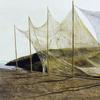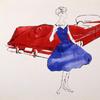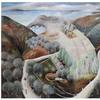Jade Jewelry & Historic Gifts at Gianguan Auctions December 16th Sale
- NEW YORK, New York
- /
- November 28, 2019

A specially curated collection of Chinese paintings and art designed to express the importance of a gift - be it personal or business related - will grace Gianguan Auctions’ Holiday Sale on Monday, December 16.
The auction opens with 50 lots of desirable carved jade pendants, bracelets and necklaces in lustrous white, apple green, lavender, coral red, yellow and classic suffusions.
Serious jewelry collectors will appreciate a court necklace that features 108 pink jade beads evenly interspersed with larger lapis lazuli rounds. In the center, a lapis lazuli double-gourd floats above a beiyun, “back cloud”.
By the 18th c. the Qing had produced a book of protocol entitled the "Illustrated Catalogue of Ritual Paraphernalia." Yellow, reserved for the Chinese royal family, was considered the most auspicious of colors. Seldom does a yellow summer robe come to auction. This one is heavily embroidered with a five-clawed front facing dragon and the 12 Symbols of Imperial Royalty. A high standard of preservation has resulted in even color.
For aficionados of Chinese seals, the highlight of the collection is a set of 4 jade seals with tiger heads atop rectangular bases. Incised on the bottom are the titles of Eastern Han generals.
Zisha clay teapots, prized for absorption properties that add subtlety to flavors, are a Gianguan Auctions specialty. The day’s highlight is a set of nine moulded pots, each decorated with two luohans engaged in an appropriate activity. All are topped with a longevity peach and have handles and spouts shaped like a peach tree trunk.
Connoisseurs of Chinese carved jades will dwell on a collection that includes both significant works of art and scholars items. The marquee jade is a 13" tall, open-work sculpture of 9 cranes amidst lingzhi and pines — symbols of longevity. The white, translucent stone sits on a harmoniously carved wooden base.
A pair of Han reticulated jade censers allude to the evolution of the Chinese march to artistic perfection. Of tubular form with a center band, the upper half and covers are reticulated, contrasting linear with curvilinear form. The lower half is incised with Kui dragons, zoomorphic forms and masks. Set atop a double form base on supporting feet, the 8” tall pair dramatic in their tonality.

Personal items include a Ming brush washer carved from a mottled spinach green boulder featuring four flaming dragons amidst fluffy clouds. Also, of rare light green tones is an archaic-style reed vase with carved landscapes and beast-head handles.
A collection of Chinese paintings - the ultimate heritage gift - leads with "Breakoff" by Yuan Dynasty master Zhao Mengfu . Zhao advocated a return to a more traditional style of calligraphy that ran through the Wei and Jin Dynasties.
From Cheng Shifa (1921-2007) comes "Spring," a bold interpretation of a rural couple on a tractor, laden with packages, making their way through a blizzard. The image pops with bright reds and greens, speaking to the power of the Dazhai movement after the “Gang of Four” had been apprehended. Dated 1963.

Li Keran (1907-1989), beloved for his paintings of shepherds and water buffalos, provides an atypical breath of his mettle in a Resounding Waterfalls. The dark, towering landscape broken by a pale house on one level and its bridge on another, is remarkable for waterfalls that tumble from an unseen heights to lowland rocks.
A group of three gilt-silver Apsara sculptures capture the graceful femininity of the attendant to deities. First, she floats amidst a trail of scarves and sashes over a base of clouds, playing the pipa, a four-stringed instrument said to sooth the longings of the Tang court. Then, entwined in a billowing scarf, she presents a frontal view and holds the pipa vertically over a shoulder. In the final manifestation, she relaxes, sensually wrapped in skirt and scarf, holding a bowl of fruit above her head, a floral finial in the other hand. The Tang group of well cast sculptures have brilliant patinas, and are each between 8” and 13” tall with proportionate width.
Qinbai, a glaze perfected as early as the 11th C., and now highly applauded for it’s pale blue-green tint, washes a seated Guanyin of Yuan origin. With exposed chest entwined in bejeweled chains, and dressed in a voluminous robe, the altar-piece embodies the best characteristics of early votive art. Adding to its rarity is the qinbai glaze that also decorates the Fonthill Vase, the oldest known piece of Chinese ceramics in Europe. The Guanyin, with serene countenance, could be a valued icon for home or temple.
Of the Tang Dynasty, Lot 92 is a polychrome wood statue of a Guanyin on a rock outcropping. Its bearing is regal, its expression serene and it long flowing robes appropriate to the period. Rarely do 7th-10th C. Guanyins come to the podium. This on has traces of original red and blue pigment.
A Tibetan gilt-cloth thangka of White Tara seated in dhyanasana and surrounded by deities, all finely finished with flourishes of gilt is simply outstanding. As is a framed wall fresco depicting Parnashavari with three heads and six hands is a 19th C. mural from an unknown location.
It bears mentioning that votive icons run throughout the auction at prices of $1,000 or less. Two are Lot 204, a turquoise carved Buddha, and Lot 99 an Eight Immortals brush pot.
Gianguan Auctions’s live previews begin on Saturday, Dec.7 and run through Sunday, Dec. 15 (10 am - 7 pm) at the W. 56th gallery. The day-of- auction preview closes at 5 p.m. The sale starts at 6 p.m. EDT. Catch it live or online at liveauctioneers.com and invaluable.com.

270x400_c.jpg)




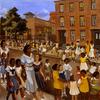



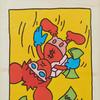
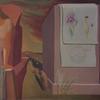
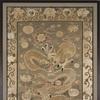
100x100_c.jpg)

